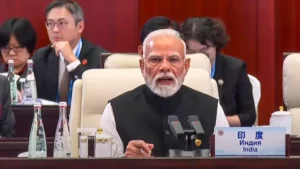With uncontrolled carbon dioxide emission, China lets Pacific Island nations down
Laggards deride people who try to perform. China is no exception. With no sincerity in its effort to reduce the emission of greenhouse gases, China has now started deriding the landmark climate legislation of the United States signed into law by President Joe Biden in the third week of August, 2022.
“Good to hear. But what matters is: Can the US deliver,” was the sarcastic comment of the Foreign Ministry of China on August 17, in the form of a tweet. The measured response of U. S. Ambassador to China Nicholas Burns, again in the form of a tweet, was: “You can bet America will meet our commitments.” The U.S. envoy also called upon Beijing to resume the suspended climate talks, which China has walked out of; taking the excuse of the visit of Speaker of U. S. House of Representatives Nancy Pelosi to Taiwan.
What may not be music to the ears of Beijing is that China overtook the U.S. in annual emissions in 2006 and has remained the world’s biggest emitter ever since, says a CNN report. Carbon emissions by China tripled between 2000 and 2019. Meanwhile, carbon emissions by the U.S. have dropped slightly over the past decade, according to published figures.
Though the U. S. is still the second highest emitter of carbon dioxide, it is way behind China in this dismal record. China, the biggest emitter of carbon dioxide, releases nearly 30 percent of the carbon dioxide produced in the world by human activities, according to figures that surfaced during the climate summit in Glasgow in 2021; COP26.
In 2019, China emitted 9.9 billion tonnes of carbon dioxide, according to an estimate of the International Energy Agency. The emission by the U.S. that year was 4.7 billion tonnes. According to the Global Carbon Atlas, for 2019, the respective figures for China and the U.S. were 10.5 billion tonnes and 5.2 billion tonnes.
“The People’s Republic of China accounted for almost all of the global increase in electricity and heat sector emissions between 2019 and 2021. A small decline from the rest of the world was insufficient to offset the increase from China,” said Global Energy Review: CO2 emissions in 2021; by IEA.
The success of a global strategy to reduce the emission of greenhouse gases and combat global warming clearly lies on cooperation between China and the USA, the two biggest emitters of carbon dioxide, to arrive at an acceptable strategy. In this background, the move of Beijing to walk out of climate talks with Washington making Taiwan the pretext has been described as “fundamentally irresponsible,” punishing the whole world.
It is going to be a short-sighted move on the part of Beijing to betray its insincerity in arresting global warming as this will finally disillusion the small Pacific Island countries of the Chinese intentions and dissuade them from falling into Beijing’s orbit. Dame Meg Taylor, a politician of Papua New Guinea who served as the Secretary General to the Pacific Islands Forum from 2014 to 202,1 in a news conference before laying down office in May 2021 had said climate change presented the greatest security threat to the Pacific Island states.
Her apprehensions are not unfounded. Saber Salem writes in E-International Relations: “Climate change could result in many of the Pacific Island nations being wiped out from the map of the world in the not so distant future. Most of these volcanic islands are barely a few metres above sea level. Ocean level rise amongst other climate changes is threatening the very existence of these geographically isolated and small land masses. Tuvalu, Kiribati and Marshall Islands are already experiencing sea level rise. Ocean flooding has washed saltwater onto agricultural land and inundated sources of drinking water. The Pacific Island states have been vocal advocates for reduction of greenhouse gas emission and active supporters of the Paris Agreement.”
Dame Meg Taylor had also held the stance of Australia in climate talks, with its emphasis on coal as source of energy, squarely responsible for Canberra losing its standing in the region. What was Australia’s loss was China’s gain. In a clever move, Beijing managed to win over the confidence of some of the Pacific Island countries, citing the Paris Agreement on Climate Change of 2016 where China stated that its carbon emission would peak in 2030 and the country would achieve a net zero emission in 2060.
The real intention of Beijing in its foray in the Pacific Island countries is not to save them from the rising ocean level but to wean them away from Taipei and use these islands as bases to interfere with the movement of forces friendly to Taiwan if Beijing finally takes recourse to military force to integrate Taiwan with China.
Dangling the carrot of 2060, in the Paris Agreement China actually obtained the licence to pollute the climate freely till 2030. Some experts believe that the Paris Agreement could fail because it allowed China to emit with abundance till 2030.
Under the cover of the lullaby of its commitment at the Paris Agreement, China has managed to sign a security agreement with Solomon Island and now getting cosy with Kiribati. At the same time, China’s emission of carbon dioxide continues to be more than double that of the USA and Beijing is going around setting up coal-fired power stations in poor countries in different corners of the world under its Belt and Road Initiative. Trashing its climate and sustainability agenda in the propaganda bin, since the Copenhagen Climate Change Conference in December 2009 China has actually managed to increase its emissions by 40 percent.
Beijing has taken advantage of the lower demand for coal due to the world progressively reducing its reliance on coal-based energy and actually increased its reliance on coal. Half of all global coal development and a quarter of all new coal projects throughout the world are financed by China, according to a study by the Asia – Pacific Centre for Security Studies.
Cynic as the leaders of the Communist Party of China are, they do not think anything about adding to global warming while the common people in China are reeling under a heat wave. According to a report in The Times, London, on August 19, 2022, the unprecedented heat wave in the summer, with the temperature hovering around 40 degrees Celsius, has prompted several Chinese provinces, including Zhejiang, Jiangsu and Anhui to ration power use amid rising demand for electricity to keep the fans and air-conditioners running.
With the landmark climate legislation by the Joe Biden government, the USA is now poised to expose the hollowness of China’s promises before the Pacific Island nations. Formally titled ‘Inflation Reduction Act of 2022,’ the Bill which President Joe Biden has already signed into legislation includes about $370 billion in clean energy and climate investment over the next 10 years.
“The historic investments included in the Inflation Reduction Act of 2022 will bring down consumer energy costs, increase American energy security, while substantially reducing greenhouse gas emissions. The combined investments in the FY2022 Budget Reconciliation Bill would put the US on a path to roughly 40 percent emission reduction by 2030,” say the Democrats in the U.S. Senate. These investments would also enable America to lessen its reliance on China in clean energy manufacturing.
CEO of Nature Conservancy Jennifer Morris has termed the U. S. initiative as “the most significant clean energy and climate legislation in the history of the nation. It will put us on a path to innovate new technologies, leverage the carbon-storing power of nature and incentivize cleaner energy,” calling it a “game-changing moment for people and nature in the United States and beyond.”
Going by the insincere Chinese attitude of making fun of the U.S. initiative, Jennifer’s hope that the “legislation also sends a signal to the rest of the world, encouraging other nations to raise their ambition and continue progress toward the shared goal of keeping global warming below 1.5 degrees Celsius” could remain unfulfilled.
Besides clean energy technology, Washington has now taken the initiative to step up its presence in the Pacific Island countries; providing an alternative to the financial resources of China. The USA has begun negotiating deals with the Marshall Islands, Micronesia and Palau. U.S. Vice President Kamala Harris on July 12. 2022, announced a series of commitments to strengthen the partnership of the U.S. with Pacific Island countries. Among them were establishing new U.S. embassies in Kiribati and Tonga, trebling the U.S. funding for economic development and ocean resilience and stepping up the presence of USAID in these countries.
According to a Voice of America report, Beijing is already feeling the pressure of Washington’s geo-political move .Foreign Minister of China Wang Yi said on May 27, 2022, in Kiribati that the United States and its allies were bent on containing China.









